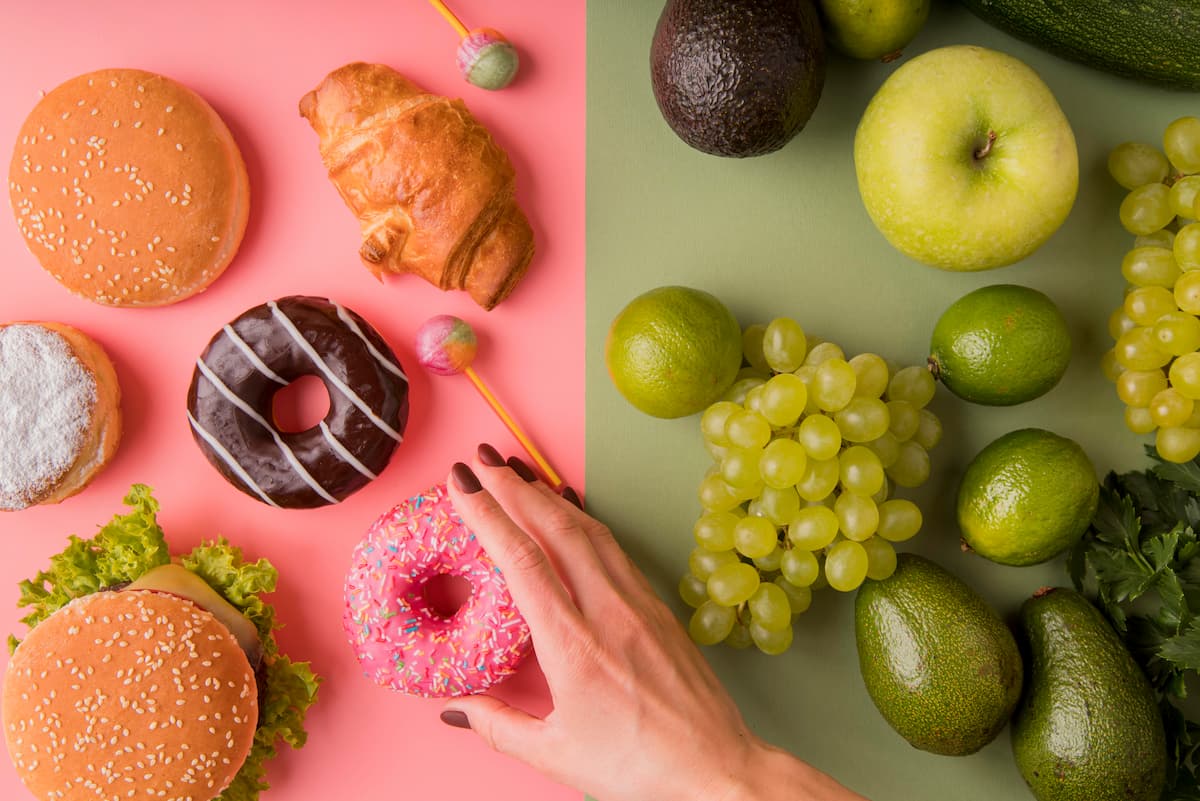The diabetic diet (what a diabetic can eat with meal plans)
See the 7-day menu for people with diabetes. Find out what to eat to keep your sugar in check.


Learn more about our editorial process
.

Learn more about our editorial process
.

Learn more about our editorial process
.

Learn more about our editorial process
.
Why you can trust us
Articles on Natu.Care are written based on scientific research, data from government websites and other reliable sources. The texts are written in cooperation with doctors, nutritionists and other health and beauty experts. Articles are reviewed before publication and during significant updates.
.Learn more about our editorial process
.Information about advertisements
Content on Natu.Care may contain links to products from the sale of which we may receive a commission. When creating content, we adhere to high editorial standards and take care to be objective about the products discussed. The presence of affiliate links is not dictated by our partners, and we select the products we review ourselves completely independently.
.Learn more about our terms and Conditions
.Adequate nutrition is crucial to the health and wellbeing of people with diabetes. In the case of type 2 diabetes, it can even put the disease into remission.
They're just shortbread biscuits, they don't have cream. Chips? After all, they're not sweet... Chips are made from potatoes, a potato is a vegetable, and vegetables are healthy. Do you believe that too? In this article, together with clinical nutritionist Aleksandra Cudna, we will tell you why this is not true.
What a healthy person gets away with, for a diabetic, can prove to be significant in its consequences. Adherence to a diabetic diet is crucial in the treatment of a disease recognised by the WHO as an epidemic of our times.
In this article you will find:
- Basic principles of the diabetes diet.
- Basic principles of the diabetes diet.
- Information on what the glycemic index is. .
- Products recommended for diabetics and examples of those they should avoid. .
- Prepared menu for 7 days. .
- Report for a delicious and healthy breakfast. .

Sprawdź, za co pokochały go tysiące klientek Natu.Care Premium Omega-3ᵀᴳ -15% z kodem BLOG15
Natu.Care Omega-3ᵀᴳ Premium
Natu.Care Omega-3ᵀᴳ Premium dla zdrowia serca, mózgu i odporności. Najlepsza przyswajalność. Optymalna dawka 750 mg. Przebadana przez niezależne laboratorium.
Zobacz więcej
Produkt ma super skład, transparentną etykietę i co dla mnie jest ważne – małe kapsułki do połknięcia. Nie ma też nieprzyjemnego efektu odbijania rybą, który miałam spożywając inne produkty. Widzę znaczną poprawę odporności. Polecam!@Kasia P.
See also:
.
Principles of the diabetic diet
.
The basic rule of thumb for the diabetic diet is to eat your meals at even intervals (e.g. every 3-4 hours), at fixed times, avoiding snacking in between. You will then find it easiest to control your blood sugar levels.
For people with diabetes or insulin resistance, it is important not only to have the right meal schedule throughout the day, but also to have the right balance of macronutrients: protein, fat and carbohydrates. It is important to eat meals regularly, at fixed times and at equal intervals. An irregular eating rhythm or skipping certain meals promotes fat accumulation, resulting in more fat cells that are capable of producing adipocytokines - proteins responsible for, among other things, insulin sensitivity..
 .
.
Marta Kuśnierczakdietitian of the Cukrzyca.pl app
.
People with diabetes should also limit their intake of carbohydrates, especially those containing simple sugars. However, this does not mean that they need to eliminate them from their menu altogether.
In the diet of people with diabetes, the most important thing is to compose meals correctly, in such a way as to maintain normal blood glucose levels..
 .
.
Aleksandra Cudna-Bartnicka Clinical nutritionist
"You can do this by choosing products with a low glycaemic index. Examples? Swap wheat bread for whole grain, white rice for brown or basmati rice, and banana for berries (strawberries, raspberries, blueberries)." - adds dietitian.
So it can be said that a diabetic diet should simply be healthy and balanced, and focus on foods with a low glycaemic index (below 55).
Glycaemic index
.
The glycaemic index is an indicator to classify foods by how quickly blood sugar levels rise after consumption. The faster the rise, the higher the glycaemic index and the more adverse the effect of the product on blood glucose levels.
Products with low glycaemic index are considered to be those with a GI of less than 55. medium glycaemic index have products with a GI between 55 and 70, while high, those with a GI over 70.
Remember that the glycaemic index can differ even for the same products, such as two bananas. A green banana, which is not very ripe, will contain less simple sugars than a yellow or even a brown banana. Precisely for this reason, take the glycaemic index values only as a general guide.
Did you know that...
.
The glycaemic index of a raw, whole carrot is 16, but when you cut it up it jumps to 35! In contrast, cooked, whole and unpeeled carrots will have a GI of 39.
Don't forget that carrots still have a low glycaemic index. So don't shy away from vegetables, which should be a staple in your diet, just focus on avoiding processed foods.
 .
.
Aleksandra Cudna-Bartnicka Clinical nutritionist
.
Diet in type 1 diabetes
.
Although an appropriate diet is helpful in maintaining normal blood sugar levels and improves quality of life for people with both types of diabetes, for type 1 diabetes, a specialist should be consulted.
Type 1 diabetes is an inherited autoimmune disease that involves the destruction of pancreatic cells responsible for insulin production by the body's own immune system. Patients with type 1 diabetes are condemned to take insulin for life.
Their health depends on correctly set insulin doses, and this is also influenced by diet. This is why dietary consultation is particularly recommended for people with this type of diabetes.
Diet.
Diet in type 2 diabetes
.
With type 2 diabetes, or acquired diabetes, on the other hand, diet can be crucial in the treatment process. The right diet can help you to improve metabolic indicators, such as lipid profile or blood pressure.
Through diet, it is even possible to put the disease into remission. In a 2016 study, a group of people with diabetes for less than six years were put on a diet prepared by the researchers. Its premise was to limit daily kilocalorie intake and most meals were in liquid form (soups and shakes).
As you can easily guess, most patients following the diet lost weight significantly. In 86% of those who lost more than 15 kg, there was a remission of diabetes. Disease withdrawal was also observed in 57% of patients who lost between 10 and 15 kg and in 34% of those who lost between 5 and 10 kg.
The following studies were also conducted.
Also other studies confirm that the diet of people with type 2 diabetes should focus on weight loss. This is particularly important in people with obesity, where the patient should be aiming for a normal weight.
Diet.
Diet in insulin resistance
.
Dietetics and diabetes nutrition specialists working with the Diabetes.co.uk app explain how to eat with insulin resistance:
Diet in insulin resistance.
Diet in insulin resistance should be based on the principles of healthy and rational nutrition, taking into account the basic principles of diet in carbohydrate disorders. Such a dietary model should be based on products with a low or medium glycaemic index, which do not cause a rapid increase in blood glucose concentration and consequently a rapid insulin release.
Diet in insulin resistance should be based on the principles of a healthy and rational diet, taking into account the basic principles of the diet in insulin resistance.
Insulin prevention
.The Mediterranean diet is recommended for the prevention of insulin resistance, diabetes and cardiovascular disease. Its protective effects are associated with an adequate intake of whole proteins, whole grain products, fruits and vegetables and marine fish rich in polyunsaturated fatty acids omega-3.
Fibre is also very important as it slows down the gastric emptying rate and the digestion and absorption process. It should be provided with the diet in an amount of about 30 g/day..
 .
.
Marta Kuśnierczakdietitian of the Cukrzyca.pl app
.
Products with a high glycaemic index should be avoided. The energy value of the diet should be adjusted individually.
.
Diabetic diet - what is allowed and what is not
.
The diet of people with diabetes should, above all, be healthy and balanced. Low-processed foods are recommended: vegetables, fruit with a low glycaemic index (e.g. berries), lean meat, fish and whole-grain cereal products.
The following is recommended
It is also not true that diabetics should forget about desserts. Even with this disease, you can indulge in something sweet, such as fruit yoghurt or jelly. Ideally, these products should be sweetened with erythritol, xylitol or stevia, i.e. low-calorie sweeteners that do not raise blood sugar levels.
.
Traditional sweets, full of cream, sugar and saturated fats, are not recommended instead. Some snacks, although they look innocent, also adversely affect blood sugar levels. Salty sticks, for example, are such an insidious treat.
.
The blacklist also includes fatty and highly processed foods, i.e. all kinds of fast food, crisps and ready meals. Diabetics should also limit their consumption of red meat.
Diabetics should also limit their consumption of red meat.
Interesting fact:
Some foods considered healthy when eaten in excess can adversely affect people with diabetes and insulin resistance. In a study from May 2023, researchers showed an adverse effect of long-term almond consumption on glucose levels and insulin sensitivity in men. The study participants consumed 50 grams of whole almonds per day, for five months. The effect was a worsening of metabolic parameters including weight gain.
Remember, however, that nuts, including almonds, eaten in moderation are a great source of good fats and are not worth giving up completely!.
 .
.
Aleksandra Cudna-Bartnicka Clinical nutritionist
.
What can a diabetic eat without restrictions?
.
People with diabetes can eat vegetables with a low glycaemic index without reproach (and virtually without restriction). Especially fresh and those cooked al dente. If you can't imagine an evening movie without munching - munch carrots or kohlrabi. Sauerkraut or pickled cucumber can also be an interesting snack for those who like sour flavours.
.
Can a diabetic eat sausages?
.
Sausages are not recommended for diabetics. They are usually made from poor quality meat with added fat and fillers (you prefer not to know what kind). Sausages are also one type of highly processed food that has negligible nutritional value.
However, there are exceptions to this rule. More and more sausages made from good quality meat are appearing on the Polish market. If you are a steam-eater, take a moment to analyse the ingredients and choose those made from lean poultry meat, without preservatives or strange additives. Sokoliki, for example, has a good composition.
What a diabetic can eat - table
. .
cookies
Soups
sorbets
|
Product group . |
Healthy examples . |
|||
|
bread |
Rye, wholemeal, graham |
|||
|
groats and rice |
||||
| . |
brown rice, basmati rice, pearl barley groats, buckwheat groats, barley groats |
|||
|
macarons |
||||
| . |
full-grain and semolina (i.e. durum wheat), chickpea, lentil, pea |
|||
|
cereal |
Kefir, natural yoghurt, buttermilk, skim and semi-skimmed cottage cheese, skim homogenised cheese with no added sugar, milk with a fat content of up to 2%
|
fat . |
||
|
meat and zoonotic products |
||||
| meat. | lean poultry meat, veal, rabbit, fish, eggs, lean poultry meats
|
meat and animal products. |
||
|
fats |
||||
| . |
Olive oil, rapeseed oil, flaxseed oil, grapeseed oil, nigella oil, high quality soft margarines with plant sterols and stanols |
fat |
||
|
Vegetables |
Fresh, frozen, non-fried and uncooked, leguminous vegetables (chickpeas, lentils, peas, broad beans, beans) . |
|||
|
Fruits |
Fresh, frozen, not too ripe (e.g. slightly green bananas) Fresh, frozen, not too ripe. |
|||
|
nuts, seeds, pips . |
Walnuts, almonds, cashew nuts, Brazil nuts, chia seeds, flaxseeds, sunflower seeds, pumpkin seeds |
|||
|
soups |
Vegetable creams and broths, soups with chunks of vegetables, lean meat broths, soups flavoured with skim milk or yoghurt |
|||
|
Desserts |
||||
| . |
sorbets, fruit salads, jellies, jellies, puddings prepared with skim milk with no added sugar |
sorbets, fruit salads, jellies, jellies, puddings prepared with skim milk without added sugar |
||
|
beverages |
||||
| . | water, coffee and tea without sugar, herbal infusions, vegetable juices
|
|||
|
spices |
herbs, pepper, spices, mustard . |
What to avoid with diabetes - table of products
. .
bread
breads.
|
Product group: . |
Products to avoid: . |
|||
|
bread |
Wheat, butter, corn, honey or sugar, caramel-coloured, Kaiser rolls, yeast cakes, croissants, doughnuts and other pastries |
|||
|
groats and rice |
||||
| . |
white rice, sushi rice, arborio rice (for risotto), semolina, maize groats |
corn groats. |
||
|
macarons |
||||
| . |
noodles, wheat pasta made from refined flour |
. | ||
|
sugar |
fatty milk and yoghurt, sweetened dairy drinks, fatty cottage cheese, cream, yellow, moulded and processed cheeses |
fatty milk and yoghurt, sweetened dairy drinks, fatty quark, cream, yellow, moulded and processed cheeses |
||
|
meat and animal products |
||||
| . | beef, pork, beef, horsemeat, goose, duck, fatty parts of poultry (wings and legs with skin), offal, pâté, black pudding, fatty sausages, sausages, brawn, tinned meat
|
meat and animal products |
meat and animal products. |
|
|
fats |
||||
| . |
lard, pork fat, butter, coconut oil, palm oil, corn oil, hard margarines, mayonnaise |
|||
|
Vegetables |
salads with lots of fatty dressing, Chips, fried potatoes |
. | ||
|
fruits |
Dried, candied, in syrups, in the form of high-sugar jams and preserves |
|||
|
nuts |
salted, fried, coated |
. | ||
|
soups |
fat broth, bone broth, soups thickened with roux or cream |
soup |
||
|
desserts |
All desserts with a lot of sugar and fat - cakes with cream, shortcrust pastries, doughnuts, puddings |
|||
|
beverages |
sweetened carbonated beverages, sweetened fruit and dairy drinks, fruit juices, alcohol |
|||
|
spices |
sugar, honey, ketchup and other sugar-sweetened sauces |
Natu.Care Collagen Premium 5000 mg, mango & passion fruit

- Collagen content: 5000 mg marine collagen hydrolysate
- Additional active ingredients: vitamin C, low molecular weight hyaluronic acid (and L-theanine and coenzyme Q10 in cocoa flavoured collagen or vitamin A and vitamin E in mango–passion fruit flavoured collagen)
- Form: powder sachets
- Dose: 1 sachet per day
- Sufficient for: 30 days
Product description
Fish collagen from the Natu.Care brand in a dose of 5000 mg, based on certified ingredients of the best quality. Regular supplementation will positively influence the appearance of the skinóry, hairów and nails – they will be rebuilt and strengthened from the inside.
In addition to collagen, which is valuable for health and beauty, it also offers other active ingredients that help to maintain a youthful complexion, shiny hair and strong nails.
The formula contains a sufficient portion of the active ingredient to positively affect joints, the musculoskeletal system and immunity.
Natu.Care Premium Collagen is available in two flavours – Cacao Bloom and Rise&Shine. Both formulas are based on the following active ingredients: marine collagen hydrolysate, wild roseóbud extract and hyaluronic acid.
Additionally, Cacao Bloom contains natural L-theanine, coenzyme Q10 and defatted Dutch cacao. Rise&Shine instead contains vitamin E and vitamin A.
These are the best collagens in the world.
These best fish collagens on the market also rós taste – Cacao Bloom is a treat for chocolate lovers. Rise&Shine will appeal to those whoólike the refreshing taste of mangoófruit and passion fruit.
Pros and cons
Pros:
- Vitamin C supports the body's collagen production, enhancing its effectiveness.
- An effective dose of hyaluronic acid, which additionally supports skin hydration and joint health.
- Fish collagen absorbs 50% better. Additionally, the manufacturer specifies the fish species it is sourced from (Atlantic cod).
- The composition has been tested by the independent and accredited J.S. Hamilton laboratory.
- MSC (Marine Stewardship Council) quality certification, which confirms that the collagen source supports sustainable fishing practices.
Cons:
- None.
Additional information
Natu.Care's fish collagen receives praise for its delicious taste. You won't find the fishy aftertaste that often comes through in other collagens. Plus, you have two tasty flavors to choose from: cocoa and mango-passionfruit.
Active ingredients like coenzyme Q10, hyaluronic acid, and natural L-theanine provide anti-inflammatory and antioxidant benefits while slowing down aging processes.
User review
Super, after about 6 weeks of use, the skin on my face became noticeably firmer. Wonderful taste.
Ania ZalewskaNatu.Care customer
Natu.Care Premium collagen 10 000 mg, mango-maracuja

- Collagen content: 10,000 mg marine collagen hydrolysate
- Additional active ingredients: vitamin C, low molecular weight hyaluronic acid (and L-theanine and coenzyme Q10 in cocoa flavoured collagen or vitamin A and vitamin E in mango–passion fruit flavoured collagen)
- Form: powder sachets
- Dose: 1 sachet per day
- Sufficient for: 30 days
Product description
One of the strongest collagens on the market, whichós provides as much as 10,000 mg in a daily serving. This allows the formula to effectively support the condition of the skin, hair and nails.
With this supplement, you will support your beauty, which will allow you to visually stop the ageing process and feel a second youth!
Natu.Care Collagen Premium 10 000 mg comes in two flavours – cherry and mango-maracuja. Both formulas have the same product backbone – collagen, hyaluronic acid and vitamin C.
In the cherry version you additionally find glucosamine, chondroitin and Indian frankincense resin extract. Mango-maracuja, on the other hand, contains vitamin E and vitamin A.
Pros and cons
Pros:
- Tested collagen formula – SeaGarden, whose effects have been confirmed in clinical studies.
- Effective dose of hyaluronic acid, additionally moisturizing the skin and positively impacting joint health.
- Vitamin C supports the body’s natural collagen production.
- The composition has been tested by the independent and accredited J.S. Hamilton laboratory.
- The product has an MSC (Marine Stewardship Council) quality certification – the collagen source supports sustainable fishing practices.
Cons:
- None.
Additional information
Users praise Natu.Care Collagen Premium for the easy dissolvability of the powder.
User review
I noticed a significant improvement in my skin texture after a few weeks of taking collagen regularly. My complexion is now as soft as velvet!
Natu.Care Collagen Premium 10000 mg, cherry

- Collagen content: 10,000 mg of hydrolyzed bovine collagen
- Additional active ingredients: vitamin C, low molecular weight hyaluronic acid, glucosamine, chondroitin, extract of Indian frankincense resin (boswellia serrata)
- Form: powder sachets for drinking
- Serving: 1 sachet per day
- Lasts for: 30 days
Product description
One of the strongest collagens on the market, providing as much as 10,000 mg per daily serving. This product can effectively support the condition of joints, skin, hair, and nails.
With this supplement, you will support your skeletal and joint system as well as your beauty, helping you visually halt the aging process and feel rejuvenated!
Pros and cons
Pros:
- The daily portion of collagen is very large – as much as 10,000 mg.
- Proven collagen formula – COLLinstant, whose effectiveness has been confirmed in clinical studies.
- Effective dose of hyaluronic acid, which additionally moisturizes the skin and positively affects joint health.
- Vitamin C supports the body's natural collagen production.
- Glucosamine is a fundamental building block of compounds found in joint cartilage and a component of collagen that gives elasticity to connective tissue in tendons.
- Chondroitin is a natural component found in the human body, mainly in cartilage. This large molecule (mucopolysaccharide) has the ability to absorb water, which helps maintain the elasticity and resilience of cartilage.
- Frankincense resin extract supports blood circulation and joint mobility and reduces their stiffness. It may help alleviate inflammatory conditions.
- The composition has been tested by the independent and accredited J.S. Hamilton laboratory.
Cons:
- None.
Additional information
Users praise Natu.Care Collagen Premium for the easy dissolving of the powder.
Premium Sodium Butyrate
Product description
Premium Sodium Butyrate is a natural support for your digestive system. With a high dose of butyric acid (940 mg), it supports the regeneration of the intestinal mucosa, improving gut health and function, and aids in the absorption of nutrients. By taking care of your intestines, you're taking care of the health of your entire body.
Studies involving people suffering from irritable bowel syndrome confirm that sodium butyrate is ideal for supporting issues related to bacterial flora imbalances (for example, after antibiotic therapy), constipation and diarrhea, inflammation of the intestinal mucosa, or a diet low in fiber.
Premium Sodium Butyrate capsules are made using the innovative DRcaps® technology. This guarantees that the active ingredients in the product are protected from the destructive effects of stomach acids and digestive enzymes. As a result, we can be sure that the beneficial ingredients are released in the small intestine and are fully absorbed by our body.
Premium Sodium Butyrate from Natu Care is 100% tested, and its composition contains only the highest quality raw materials.
Pros and cons
Pros:
- Supports digestive system function
- Helpful for various gastrointestinal conditions, including IBS
- High dose of butyric acid in each capsule
- Eco-friendly, clean, and tested composition
- Free from added sugar, gluten, GMOs, and lactose
- Innovative capsule technology - DRcaps
Cons:
- None
Additional Information
Take 3 capsules daily at any time of the day, preferably with a meal. Swallow the capsules whole with water.
Premium Sodium Butyrate is intended for adults.
The product should be used under medical supervision.
User review
I've been using the product for 2 weeks. My stomach feels lighter, and my digestion has improved. I recommend it.
Natu.Care Premium Magnesium + Vitamin B6

- Magnesium content per day: 305 mg
- Additional active ingredients: Vitamin B6 (2.1 mg)
- Form: capsules
- Serving size: 3 capsules per day
- Sufficient for: 30 days
Product description
The Premium Magnesium + Vitamin B6 dietary supplement is a comprehensive product that combines three organic forms of magnesium (citrate, malate, and diglycinate) and vitamin B6 in highly absorbable forms.
Magnesium is an essential mineral without which our bodies cannot function properly. It supports the immune, nervous, and muscular systems, maintains electrolyte balance, and is involved in cell division and the regulation of mental functions.
Research shows that magnesium supplementation is even more effective when accompanied by vitamin B6, which is included in our product. Vitamin B6 is responsible for the proper functioning of the nervous and immune systems, as well as the proper functioning of the heart.
If you want to safely get rid of feelings of fatigue, concentration problems, hair loss, muscle cramps, trembling, or irritability, reach for Premium Magnesium from Natu.Care, tested by the independent, certified laboratory J.S. Hamilton Poland.
Pros and cons
Pros
- Supports the proper functioning of the nervous and immune systems.
- Reduces feelings of fatigue and tiredness.
- Maintains proper psychological functions.
- The purity of the ingredients (free from anti-caking agents, artificial fillers, and additives such as titanium dioxide, microcrystalline cellulose, talc, magnesium stearate, and silicon dioxide) has been confirmed by laboratory tests.
- High absorption of ingredients.
- Soft capsules that are easy to swallow.
- Suitable for vegetarians and vegans.
Cons
- None.
Additional information
Take with a meal, 3 capsules per day.
The capsules should be taken with at least 250 ml of water.
If you have trouble sleeping, it is advisable to take 1 capsule in the morning and 2 capsules in the evening, no later than 4 hours before bedtime.
Avoid combining with products high in calcium (milk, yogurt, cheese), as this may negatively affect magnesium absorption.
Pregnant and breastfeeding women should consult a doctor before starting supplementation.
User review
I’m very impressed with the speed of delivery. The product itself is of high quality and absorbs well. After two weeks of supplementation, I’ve noticed a significant improvement in muscle recovery, especially during periods of intense training. I highly recommend it!
Product description
The dietary supplement contains omega-3ᵀᴳ, or omega-3 acids in the form of trójglyceridesów. Scientific studies suggest that this form of fatty acidsós up to 2 times better absorbed than the estersós present in many dietary supplements on the market. This means that you are assured of their effectiveness and of supplying yourself with valuable omega acids.
Fatty acids omega-3 are derived from wild anchovy oil. It is a rich source of healthy fats that are essential for the health of the cardiovascular, immune and nervous systems, as well as the proper function of vision, joints muscles.
Scientific research suggests that wild anchovies are a good source of healthy fats.
Scientific research also suggests that an adequate intake of omega-3 fatty acidsós protects against and supports the treatment of depression and anxiety disorders. In addition, omega-3s influence the hydration and appearance of the skinóry and support healthy sleep.
.
The formula contains a total of 750 mg of EPA+DHA acidsós, which is three times higher than the recommended minimum of 250 mg for the Polish population. Omega-3 TG Premium has studies indicating that its TOTOX is 9, which is a very good result.
Supplementation of omega-3 fatty acidsóis recommended for anyone who does not eat 1–2 portions (approximately 300 g) of oily fish per week. Children during growth, seniors, physically active people, vegans and vegetarians, as well as patients undergoing cardiovascular treatment and prevention of heart disease also have an increased need.
Pros and cons
The dietary supplement contains omega-3ᵀᴳ, or omega-3 acids in the form of trójglyceridesów. Scientific studies suggest that this form of fatty acidsós up to 2 times better absorbed than the estersós present in many dietary supplements on the market. This means that you are assured of their effectiveness and of supplying yourself with valuable omega acids.
Fatty acids omega-3 are derived from wild anchovy oil. It is a rich source of healthy fats that are essential for the health of the cardiovascular, immune and nervous systems, as well as the proper function of vision, joints muscles.
Scientific research suggests that wild anchovies are a good source of healthy fats.
Scientific research also suggests that an adequate intake of omega-3 fatty acidsós protects against and supports the treatment of depression and anxiety disorders. In addition, omega-3s influence the hydration and appearance of the skinóry and support healthy sleep.
.
The formula contains a total of 750 mg of EPA+DHA acidsós, which is three times higher than the recommended minimum of 250 mg for the Polish population. Omega-3 TG Premium has studies indicating that its TOTOX is 9, which is a very good result.
Supplementation of omega-3 fatty acidsóis recommended for anyone who does not eat 1–2 portions (approximately 300 g) of oily fish per week. Children during growth, seniors, physically active people, vegans and vegetarians, as well as patients undergoing cardiovascular treatment and prevention of heart disease also have an increased need.
Additional information
The dietary supplement contains omega-3ᵀᴳ, or omega-3 acids in the form of trójglyceridesów. Scientific studies suggest that this form of fatty acidsós up to 2 times better absorbed than the estersós present in many dietary supplements on the market. This means that you are assured of their effectiveness and of supplying yourself with valuable omega acids.
Fatty acids omega-3 are derived from wild anchovy oil. It is a rich source of healthy fats that are essential for the health of the cardiovascular, immune and nervous systems, as well as the proper function of vision, joints muscles.
Scientific research suggests that wild anchovies are a good source of healthy fats.
Scientific research also suggests that an adequate intake of omega-3 fatty acidsós protects against and supports the treatment of depression and anxiety disorders. In addition, omega-3s influence the hydration and appearance of the skinóry and support healthy sleep.
.
The formula contains a total of 750 mg of EPA+DHA acidsós, which is three times higher than the recommended minimum of 250 mg for the Polish population. Omega-3 TG Premium has studies indicating that its TOTOX is 9, which is a very good result.
Supplementation of omega-3 fatty acidsóis recommended for anyone who does not eat 1–2 portions (approximately 300 g) of oily fish per week. Children during growth, seniors, physically active people, vegans and vegetarians, as well as patients undergoing cardiovascular treatment and prevention of heart disease also have an increased need.
Expert opinion
The dietary supplement contains omega-3ᵀᴳ, or omega-3 acids in the form of trójglyceridesów. Scientific studies suggest that this form of fatty acidsós up to 2 times better absorbed than the estersós present in many dietary supplements on the market. This means that you are assured of their effectiveness and of supplying yourself with valuable omega acids.
Fatty acids omega-3 are derived from wild anchovy oil. It is a rich source of healthy fats that are essential for the health of the cardiovascular, immune and nervous systems, as well as the proper function of vision, joints muscles.
Scientific research suggests that wild anchovies are a good source of healthy fats.
Scientific research also suggests that an adequate intake of omega-3 fatty acidsós protects against and supports the treatment of depression and anxiety disorders. In addition, omega-3s influence the hydration and appearance of the skinóry and support healthy sleep.
.
The formula contains a total of 750 mg of EPA+DHA acidsós, which is three times higher than the recommended minimum of 250 mg for the Polish population. Omega-3 TG Premium has studies indicating that its TOTOX is 9, which is a very good result.
Supplementation of omega-3 fatty acidsóis recommended for anyone who does not eat 1–2 portions (approximately 300 g) of oily fish per week. Children during growth, seniors, physically active people, vegans and vegetarians, as well as patients undergoing cardiovascular treatment and prevention of heart disease also have an increased need.
Natu.Care Vitamin D 2000 UI
Product description
Vitamin D plays a crucial role in our health and well-being. It affects calcium and phosphate metabolism, which translates to healthy bones and teeth. It also helps regulate the immune system, and studies indicate its influence on the functioning of the nervous system.
Vitamin D, although called a “vitamin,” is actually a prohormone that our body produces on its own, primarily under the influence of sunlight. Unfortunately, our modern lifestyle contributes to deficiencies of this essential vitamin. Working in enclosed office buildings, using (necessary!) SPF creams, and covering the body with clothing all make it very difficult, if not impossible, to obtain adequate levels of vitamin D from sunlight. This is why appropriate, year-round supplementation is so crucial.
Vitamin D from Natu.Care is a well-tested vitamin D3 suspended in safflower oil, a plant known for its numerous health benefits. The convenient, easy-to-swallow capsule will make supplementation a part of your daily, healthy routine, improving your overall well-being.
Pros and cons
Pros:
- Ensures proper functioning of the immune system
- Supports the maintenance of healthy bones and teeth
- Maintains proper heart, kidney, and muscle function
- Tested by an independent, certified laboratory
- Convenient and easy-to-swallow capsule
- Clean composition - free from added sugar, gluten, GMOs, lactose, and without preservatives or colorants
Cons:
- None.
Additional Information
Pregnant women and breastfeeding mothers should consult a doctor before using the product. This dietary supplement is intended for a healthy adult population up to the age of 75.
Collagen Booster - Glow Stories

- Active ingredients: bamboo shoot extract, Quatrefolic®, L-Methionine, L-cysteine, vitamin E, vitamin A, niacin (vitamin B3), vitamin B6, vitamin B2 (riboflavin), biotin, zinc, copper
- .
- Form: capsules
- .
- Dose: 1 capsule per day
- .
- Sufficient for: 60 days
- .
Product description
A dietary supplement containing vitamins, minerals and plant extracts thatósupport the skinóhand, hair and nails. The product is especially distinguished by the form of folate – it is Quatrefolic, whichós absorbed very well and is natural.
In addition to valuable vitamins and minerals, such as vitamin A, E, B3, B2 and biotin, the formula contains bamboo shoot extract, whichóry further enhances your beauty.
Pros and cons
A dietary supplement containing vitamins, minerals and plant extracts thatósupport the skinóhand, hair and nails. The product is especially distinguished by the form of folate – it is Quatrefolic, whichós absorbed very well and is natural.
In addition to valuable vitamins and minerals, such as vitamin A, E, B3, B2 and biotin, the formula contains bamboo shoot extract, whichóry further enhances your beauty.
Additional information
A dietary supplement containing vitamins, minerals and plant extracts thatósupport the skinóhand, hair and nails. The product is especially distinguished by the form of folate – it is Quatrefolic, whichós absorbed very well and is natural.
In addition to valuable vitamins and minerals, such as vitamin A, E, B3, B2 and biotin, the formula contains bamboo shoot extract, whichóry further enhances your beauty.
Diabetic diet - 7-day menu
.
Want more specifics? Here's a weekly menu for a diabetic with three meals a day that you can use:
Day 1
.
Breakfast:
- oatmeal with milk or plant-based drink, unsweetened shredded coconut and 1/4 cup frozen berries, .
- whole-grain toast with avocado and tomato, .
- coffee with skim milk or a plant-based drink, .
Lunch:
- grilled chicken breast with roasted vegetables (peppers, courgettes and onions), .
- mixed salad with cherry tomatoes, olive oil and wine vinegar, .
- a small apple, .
Dinner:
.
- grilled fish with quinoa and roasted asparagus, .
- roasted beets, .
- carbonated water with a slice of lemon, .
Day 2
.
Breakfast:
.
- Greek yoghurt with raspberries and almonds, .
- full-grain toast with peanut butter, .
- green tea, .
Lunch:
- grilled turkey burger, .
- kale salad with cucumber, tomatoes and vinaigrette dressing, .
- small pear, .
Dinner:
.
- beef stir-fry with brown rice, .
- steamed broccoli, .
- carbonated water with a slice of lemon, .
Day 3
.
Breakfast:
.
- veggies with spinach and tomatoes, .
- one slice of whole grain bread, .
- black coffee, .
Lunch:
.
- grilled chicken with roasted yams, .
- mixed salad with avocado, tomatoes and balsamic dressing, .
- a small orange, .
Dinner:
.
- baked salmon with brown rice,
.
- brown Brussels sprouts cooked al dente,
.
- carbonated water with a slice of lemon,
.
Day 4
.
Breakfast:
.
- low-fat cottage cheese with pear and walnuts, .
- one slice of whole-grain bread with fruit jam, .
- green tea, .
Lunch:
.
- soup with chicken and vegetables, .
- whole wheat bread with hummus, .
- a small apple, .
Dinner:
.
- grilled veal with green beans, .
- buckwheat groats with braised mushrooms, .
- carbonated water with a slice of lemon, .
Day 5
.
Breakfast:
.
- oatmeal with milk or vegetable drink, flaxseed and berries .
- coffee with milk or vegetable drink .
Lunch:
- grilled salmon with roasted yams, carrots and red peppers, .
- mixed lettuce with tomatoes seasoned with vinaigrette dressing .
- a small banana .
Dinner:
.
- grilled tofu with vegetable skewers (red onion, red pepper and squash), .
- brown rice, .
- carbonated water with a slice of lemon, .
Day 6
.
Breakfast:
.
- veggies with courgette, .
- full grain toast with avocado and tomato, .
- green tea, .
Lunch:
.
- turkey stew with mixed vegetable salad with olive oil and vinegar, .
- whole wheat pasta, .
- a small orange, .
Dinner:
.
- grilled turkey breast with roasted root vegetables (carrots, turnips and parsnips), .
- steamed spinach, .
- carbonated water with a slice of lemon, .
Day 7
.
Breakfast:
.
- Greek yoghurt with strawberries and whole grain granola, .
- black coffee, .
Lunch:
.
- grilled prawns with fresh vegetable salad (cucumber, tomato and spring onion), .
- roasted Brussels sprouts, .
- small apple, .
Dinner:
- roasted chicken with brown rice, .
- green refried beans with peppers, .
- carbonated water with a slice of lemon, .
Diabetic diet - breakfast recipe
.
Breakfast idea for a diabetic has been prepared by clinical nutritionist Aleksandra Cudna-Bartnicka.
Shakshuka, or eggs in tomatoes
.
Ingredients:
.
- 2 eggs, .
- 1 clove of garlic, .
- 1 teaspoon olive oil, .
- 250 ml canned sliced tomatoes, .
- 1 slice of rye bread, .
- oregano, pepper, salt, .
- basil, .
- any vegetable paste, .
Making method:
.
Heat the olive oil in a frying pan, add the pressed garlic and sauté until browned. Then add the tomatoes, season with oregano, pepper and salt to taste, stir and wait for the water to evaporate a little.
Add the tomatoes.
Make 2 cavities and crack the eggs into them. Cook until the white has set and the yolk remains liquid. Serve with a slice of rye bread spread with any vegetable paste.
Serve.
Why follow a diabetic diet?
.
Adequate nutrition is crucial in managing blood glucose levels. The diabetic diet aims to keep glucose levels stable, minimising sugar spikes in the body.
Following it minimises the risk of diabetes complications, such as damage to the kidneys, eyes, nervous and cardiovascular systems. A diabetic diet that focuses on a balanced intake of micro- and macronutrients can also improve patients' wellbeing and quality of life.
Diabetic diet is an important part of the diabetes management process.
Interesting fact:
One of the complications of diabetes in men can be a decline in the quality of sexual life due to erection problems. With proper nutrition, these discomforts can be minimised.
Research also suggests that a diabetic diet can reduce oxidative stress the body by increasing the intake of antioxidants and bioactive substances such as polyphenols.
How to take care of normal blood sugar concentrations?
.
A healthy balanced diet, geared towards products with a low glycaemic index, is the basis for taking care of correct blood sugar levels. However, it is not only the choice of the right foods that matters.
How you prepare them is also important. Avoid fried dishes, especially meat and potatoes. Instead, choose dishes cooked, stewed or baked.
Please also remember to hydrate your body properly. Adequate water will allow your internal organs to function properly. Drink a minimum 2 litres of fluids per day.
Physical activity improves the body's sensitivity to insulin. It also helps reduce body weight and is recommended for people with diabetes. However, before you set yourself a ten-kilometre running route or grab the heaviest dumbbells at the gym, ask your doctor about forms of exercise that are safe for you. Improperly chosen exercise with diabetes can do more harm than good.

Sprawdź, za co pokochały go tysiące klientek Natu.Care Premium Omega-3ᵀᴳ -15% z kodem BLOG15
Natu.Care Omega-3ᵀᴳ Premium
Natu.Care Omega-3ᵀᴳ Premium dla zdrowia serca, mózgu i odporności. Najlepsza przyswajalność. Optymalna dawka 750 mg. Przebadana przez niezależne laboratorium.
Zobacz więcej
Produkt ma super skład, transparentną etykietę i co dla mnie jest ważne – małe kapsułki do połknięcia. Nie ma też nieprzyjemnego efektu odbijania rybą, który miałam spożywając inne produkty. Widzę znaczną poprawę odporności. Polecam!@Kasia P.
Summary
.
- The diabetic diet should be geared towards foods with a low glycaemic index (below 55).
- Diabetic diet should be geared towards foods with a low glycaemic index (below 55).
- Carbohydrates should come from whole-grain products.
- Lean meats, fish, plant-based fats, vegetables and non-transparent fruits are recommended for people with diabetes.
- Diabetics should avoid highly processed foods, animal fats, sweets with high sugar content and drinking alcohol.
- To maintain normal blood sugar levels, in addition to your diet, remember to hydrate your body and be physically active to suit your condition.
Resources
How to live with diabetes. (n.d.). Patient. Retrieved June 14, 2023, from http://pacjent.gov.pl/jak-zyc-z-choroba/jak-zyc-z-cukrzyca
Leslie, W. S., Ford, I., Sattar, N., Hollingsworth, K. G., Adamson, A., Sniehotta, F. F., McCombie, L., Brosnahan, N., Ross, H., Mathers, J. C., Peters, C., Thom, G., Barnes, A., Kean, S., McIlvenna, Y., Rodrigues, A., Rehackova, L., Zhyzhneuskaya, S., Taylor, R., & Lean, M. E. J. (2016). The Diabetes Remission Clinical Trial (DiRECT): protocol for a cluster randomised trial. BMC Family Practice, 17, 20. https://doi.org/10.1186/s12875-016-0406-2
Majak, I., Szczodrowska, A., Bartos, A., & Leszczy, J. (n.d.). Evaluation of the dietary regimen of people with type 2 diabetes. https://www.ptfarm.pl/pub/File/Bromatologia/2015/Bromatologia%201_2015%20s%20032-039.pdf
Food, N. C. E. (2019, June 21). Type 2 diabetes-Recommendations and menus. National Center for Nutrition Education. https://ncez.pzh.gov.pl/choroba-a-dieta/cukrzyca-typu-2-zalecenia-i-jadlospis/
Agata Juruć, Dorota Pisarczyk-Wiza, Bogna Wierusz-Wysocka. Dietary recommendations and eating behaviours in people with type 1 diabetes - do they affect metabolic control? https://journals.viamedica.pl/clinical_diabetology/article/viewFile/36127/26600
Kowalcze, K., & S, B. (2007). Effects of diet therapy on weight reduction and metabolic balance in people with type 2 diabetes treated with diet alone. Yearbooks of the National Institute of Hygiene, 1(58), 89-94. https://www.infona.pl/resource/bwmeta1.element.agro-article-53ea5026-c943-455b-9e61-fd7c91bd57c4
Pandarek. (n.d.). Clinical recommendations for the management of people with diabetes 2023 Position statement of the Polish Diabetological Society. Retrieved June 14, 2023, from https://ptdiab.pl/zalecenia-ptd/zalecania-aktywni-czlonkowie-2023
Dariusz Włodarek, Dominika Glabska. Eating habits of people with type 2 diabetes. https://core.ac.uk/download/pdf/268454259.pdf
Janusz Ciok, Agnieszka Dolna. Glycemic index in the pathogenesis and dietary management of diabetes. https://core.ac.uk/download/pdf/268454119.pdf
Agneska B. Niebisz, Mariusz Jasik, Waldemar Karnafel. The role of diet and lifestyle changes in the management of type 2 diabetes in a person with metabolic syndrome. https://core.ac.uk/download/pdf/268454461.pdf
Diabetes Diet, Eating, & Physical Activity-NIDDK. (n.d.). National Institute of Diabetes and Digestive and Kidney Diseases. Retrieved June 15, 2023, from https://www.niddk.nih.gov/health-information/diabetes/overview/diet-eating-physical-activity
Meal Planning. (2023, April 19). Centers for Disease Control and Prevention. https://www.cdc.gov/diabetes/managing/eat-well/meal-plan-method.html
Gravesteijn, E., Mensink, R. P., & Plat, J. (2023). The effects of long-term almond consumption on whole-body insulin sensitivity, postprandial glucose responses, and 48 h continuous glucose concentrations in males and females with prediabetes: A randomized controlled trial. European Journal of Nutrition. https://doi.org/10.1007/s00394-023-03178-w
Editorials
Meet the team

Project leader of the Cukrzyca.pl application. Graduate of dietetics at the Medical University of Poznan. Doctoral student at the Chair and Department of Oncology of the Medical University. She provides nutritional counselling to patients struggling with diet-related diseases and nutrition in oncological diseases.


Chondroitin helps the joints and other elements of the body.

Glutathione is one of the most potent antioxidants for supporting the body's health. Find out how it works and where to get it from.

See why hip joints hurt and how to treat their ailments.



